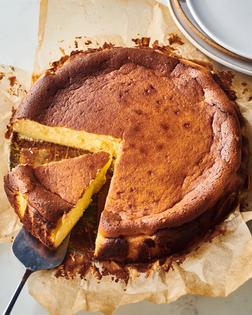The Kitchn: Here’s how to make Basque cheesecake at home (prepare to fall in love)
My first bite of Basque cheesecake was a revelation. I’ve never been a fan of super-rich New York-style cheesecake, so it was as if Basque cheesecake — which is decidedly less sweet and really lets the flavor of the cheese shine — was made for me. I was initially drawn in by its dark, almost-burnt appearance, but it was the caramelized flavor and impossibly smooth texture that had me begging the chef for his recipe.
As it turns out, not only is Basque cheesecake (or burnt Basque cheesecake) incredibly delicious, but it’s also simple to make at home. Here’s everything you need to know about this stunning Spanish sweet.
What’s the history of Basque cheesecake?
When I moved to Boise, Idaho, I was excited to learn that the city has the largest concentration of Basque residents in the United States. Reportedly, many Basque families moved from the region in northern Spain to Idaho in the 1800s to mine silver or work as sheepherders. Today, Boise has a rich Basque culture and an entire Basque block filled with restaurants, a market, and a cultural museum. This is where I had my first Basque cheesecake.
As I learned from talking with local Basque chef Asier Garcia, chef-owner of Leku Ona, Basque cheesecake is a relatively new concept. “Burnt cheesecake isn’t something our grandmothers made for us,” he said. “It came out of a restaurant called La Vina in San Sebastian in the 1990s, with almost every chef, home baker and magazine riffing on the recipe created by chef Santiago Rivera.” The story goes that Rivera had taken over the family restaurant and set out to add a simple dessert to the menu. Working within the constraints of a savory kitchen, like a hot oven that contributed the cheesecake’s dark color, this riff on classic cheesecake was born.
What does Basque cheesecake taste like?
Basque cheesecake bakes at a higher temperature than traditional cheesecake (400 F versus 350 F), giving it its deep golden hue and caramelized flavor. The burnt moniker comes only from the appearance — Basque cheesecake tastes rich and caramelly.
The other thing you’ll notice is that Basque cheesecake doesn’t have a crust. The airy batter and high heat cause the cheesecake to rise and fall in the oven a bit like a soufflé, which gives the dessert a crust-like exterior and ultra-creamy interior. Depending on the bake time, the center can range from runny (think: Camembert cheese) to fudge-like. A small amount of flour in the batter (just 1/4 cup for nearly three pounds of dairy) helps set the cheesecake and makes it sturdy enough to slice.
Basque cheesecake is also less sweet than most cheesecakes, which really lets the cheese flavor shine. “In Spain, Philadelphia cream cheese wasn’t widely available, so the original Basque cheesecakes were made without salt, because the Spanish cream cheese was already seasoned,” Garcia told me with a bit of a laugh.
Do I need a special pan for Basque cheesecake?
...continued







